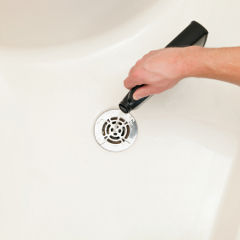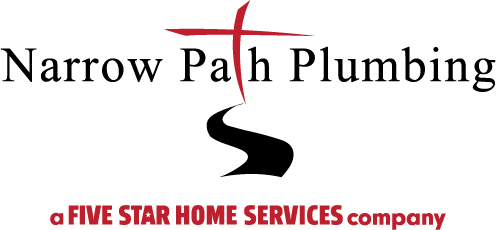
A clogged drain is one of the most common plumbing problems people call Narrow Path Plumbing about. Some drains definitely need professional intervention to be remedied, but if you take some care,you can make certain clogs go away all by yourself with a bit of know how and maybe a tool or two.
Whatever you do, you shouldn’t deal with clogs by using chemical drain cleaners. These powerful, abrasive chemicals can cause damage to many things they come in contact with like your pipes, kitchen and bath surfaces, your clothes, and even your skin. If they splash back into your eyes or other parts of your face you can be badly burned. It is best to try to unclog a drain the right way, right away, and these methods listed here should help.
The Plunger
A plunger is a must have plumbing tool that everyone should have in their home. Usually associated with clearing toilet clogs, plunging is effective in taking care of other drain clogs as well.
To unclog a drain with a plunger, you want to start with the right type of plunger. The most effective will be the standard Cup plunger, which happens to be the most popular. You will want to use a wet cloth to completely seal and cover the overflow drain. Next, you put the plunger over the drain completely, covering the opening to the drain and creating a seal. The actual plunging is done by pushing down on the plunger’s handle with quick thrusts; these should be forceful and should go on for an interval of about 15 to 20 seconds.
A quick pro tip from Narrow Path Plumbing: remove any excess water from the basin before you get to work. All of your vigorous plunging will upset all that standing water and send it splashing around everywhere. Don’t take all the water out; you need a little bit so that the plunger can make a seal.
A Plumbing Snake
Plumbing snakes or augers can be incredibly helpful in clearing a clog. These are pretty basic devices with a long, metal cable with a crank on one end, and they are easy to use.
While turning the crank handle, you should push the cable into the drain. As soon as you feel the end of the snake reach the blockage, you should pull back a bit and then push forward again while still turning to dislodge the source of the clog. If you can, you want to pull the clog out through the pipe. Keep a bucket and some heavy duty rags on hand; this could get messy.
A quick pro tip from Narrow Path Plumbing: If the clog doesn’t come up and out of the drain, you may need to find the branch cleanout in your basement or crawlspace to free the obstruction. The blockage could also be further on, and an auger may need to be run down from the roof into the vent stack. That being said, if you cannot remove the clog through the drain opening, you may want to call a plumber.
A Wire Hanger
If you don’t have a snake on hand, a wire hanger can be quite helpful in dislodging some small clogs. To turn a plain coat hanger into a tool, you should straighten the hanger out as best as you can before getting started.
You will want to bend an end of the hanger to create a hook, and you will want to push the hook into the drain and try to fish out the clog. You may not be able to pull out a major blockage in this manner, but you can remove hair and other things that tend to clog and slow your drain. Clear out as much as you can before running the hot water to rinse away residue and finish freeing up the drain.
A quick pro tip from Narrow Path Plumbing: If you start fishing in your drain with a wire hanger, be sure that you are not pushing hair and other clogging agents further in; this can increase the difficulty in fixing problems in the future. Always be pulling these clogs out.
Other Liquids
As mentioned, powerful commercial drain cleaner chemicals are not recommended because they are not safe. There are other liquids you have around the house and some concoctions you can make with household items that are safe and effective.
One such mix is baking soda and vinegar. According to one recipe, you should mix 1/3 of a cup full of baking soda to about 1/3 cup of vinegar; this solution need not be exact. The mixture will begin to fizz right away, so you should immediately pour it into the drain. The hair, slime, and other gunk that is most likely responsible for the clog should be removed from this fizzy mixture. It should be left for a minimum of an hour or as long as overnight before you flush the drain with hot water. An alternative is to pour baking soda down the sink dry, following it with vinegar.
Baking soda and salt are also known to help unclog drains. The mixture should be 1/2 cup of baking soda and 1/2 cup of table salt. These should be poured down the drain, and it should be followed with boiling water after about 10 to 20 minutes.
Boiling water alone may also be effective in removing gunk and freeing up a clogged drain. Boil as much water as you can in a tea kettle or in a measuring cup in the microwave. Pour the boiling water down the drain in stages, letting the first dose of boiling water work on the grime before you pour down more. This may not work for more advanced clogs, but it is definitely a cheap and easy thing to try first.
A quick pro tip from Narrow Path Plumbing: Trying these other methods are inexpensive, but more importantly, they are easy! Before you start to sweat trying to snake your drain or spend precious time straightening out hangers, you should consider one of these first.
And More!
These are just some of the ways that you can unclog a drain the safe way. There are plenty of other methods you can try, and some may work better for you and your clog. If things get too tough or start to get out of hand, don’t resort to those nasty, dangerous chemical drain cleaners; call a professional plumber in instead. Not only could professionals like us here at Narrow Path Plumbing unclog your drain, we can help teach you how to avoid future clogs too!




